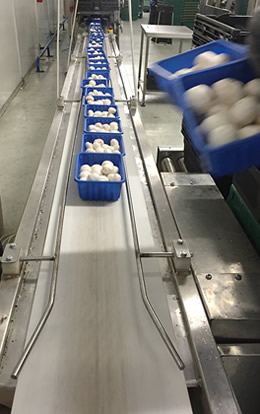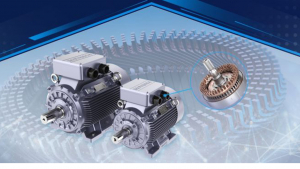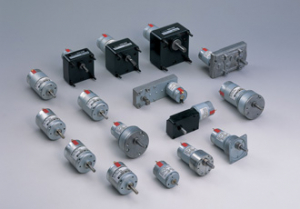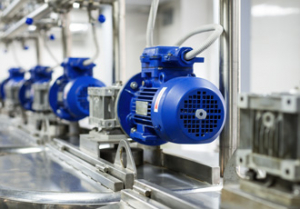Mushroom producer saves energy with variable speed drives

Turning to Mitsubishi Electric, Irish mushroom producer, Codd Mushrooms wanted to save energy and boost reliability within its factory chilled water systems. Resulting in PLC-based control system using Mitsubishi Electric variable speed drives to control the various pumps, delivering a saving of over 5400kWh in one week, which will amount to €40,000 (approx. £33,000) per year.
Codd Mushrooms production and packing facility is regarded as one of the most modern in Europe. The vacuum cooling system takes products from a field temperature of 20°C down to 3°C in just 20 minutes, a process which ensures two days extra shelf life.
Its products are committed to sustainability, and it strives to be the most environmentally friendly mushroom farm in the world, which has seen the company adopt renewable energy generation, and it is always looking for further energy savings.
Always maintaining a focus on the benefits of automation, Director, Raymond Codd explained: “Through progressive automation, we have been able to advance our production as the business has grown.”
Energy savings potential
Codd Mushrooms was keen to investigate whether energy savings could be made in the factory chilled water system, and whether reliability could be increased. The chilled water system serves the requirements of various production areas, which all work independently and need varying amounts of heating or cooling depending on the environmental conditions and the point in the production cycle. Water is initially cooled to 5°C, stored and pumped heat exchangers in the production areas. It is then returned to the chiller for recooling and reuse.
To investigate the possibilities for energy savings, Codd Mushrooms called in local Mitsubishi Electric system integrator MPAC. Director Matt Pender said: “Because the system didn’t have any way of knowing what the demand would be, it was always working at full capacity. As such, it was only ever working efficiently when demand was equal to 100% of capacity.”
“In reality, demand at the plant is dynamic. It rarely needs the full capacity, and even if it does it still won’t be a constant demand. The system demand varies hour by hour and day by day, with a number of different influencing factors, including the number of production rooms calling for cooling, the stage of the cycle the rooms are in, the external ambient temperature dictated by the local weather and the humidity.”
Even at zero demand, the old system would continue pumping the maximum volume of water and, even it wouldn’t be drawn through the heat exchangers, it would still warm up en route.
Survey
MPAC performed a thorough investigation of the chilled water system, looking at areas for improvement, and noting that it consumed 6,115kWh of energy over a seven day monitoring period.
Although a theoretical maximum efficiency could be achieved by stopping the system when there was no demand, this would lose the ability to detect when demand increased again.
Pender added: “Furthermore, if we didn’t keep some sort of buffer of chilled water, we would have a very ‘laggy’ system that was slow to respond when a given production area called for cooling.”
The solution developed by MPAC lay in between, with a calculated demand system. The various pumps in the system – including the primary pump that circulates water between the chiller and buffer tank, the secondary pump feeding the lower side of the factory, and the twinset pump feeding the upper side – were all fitted with Mitsubishi Electric FR-F740 variable speed drives. These were linked to a Mitsubishi Electric MELSEC Q series PLC via CC-Link.
Pender said: “We have worked closely with Mitsubishi Electric for many years, and have absolute confidence in the performance and reliability of its products.”
All process variables are measured by sensors and data is fed to the PLC via Mitsubishi Electric STLite remote I/O units. The PLC calculates the actual demand and appropriate response, adjusting the drives accordingly. By controlling the pumps, the flow of water is always proportional to demand. Process visualisation is via a Mitsubishi Electric GOT series HMI.
“With this system, the pumps are operating more efficiently, and the amount of warm water returning to the buffer is significantly reduced,” said Pender.
Centrifugal pumps operate on a cube law with regard to energy consumption, so even small reductions in speed can quickly deliver significant energy savings.
Monitoring consumption
Following installation of the new control system, MPAC monitored demand over a second seven day period, and saw energy consumption reduced from 6,115kWh to just 664kWh – a saving of 5,451kWh.
Furthermore, the drives have reduced electrical and mechanical stresses on the pump and motors and eliminated water hammer, so should reduce maintenance and repair costs.
Raymond Codd summed up: “MPAC, who have helped us to automate our processes using a range of industry leading solutions from Mitsubishi Electric. These have increased our productivity and overall efficiency.
“We look forward to working with them and using the innovative solutions of Mitsubishi Electric on future projects to ensure our control systems exceed the demands of future market requirements.”

Similar articles
More from Mitsubishi
- Want a robot but don’t know where to start? 11th June 2021
- A pizza challenge for Control Freaks 22nd April 2021
- Competitive factories need to leverage the power of data 15th April 2021
- Combining user-friendliness with high performance 16th March 2021












Write a comment
No comments